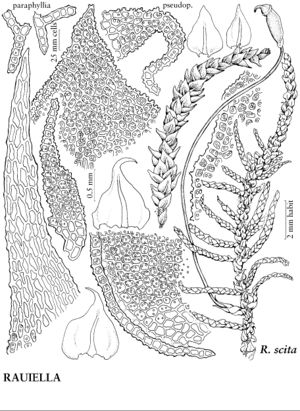Rauiella
Hedwigia 76: 287. 1937.
| Taxon | Illustrator ⠉ | |
|---|---|---|
 | Rauiella scita | Patricia M. Eckel |
Plants medium-sized. Stems creeping, ± regularly 1-pinnate; paraphyllia ± filamentous, not or weakly branched; axillary hairs 3-celled. Stem-leaves broadly ovate to cordate-deltoid; margins plane or recurved, crenulate to crenulate-papillose; costa ending near base of acumen; laminal cells ± quadrate, multipapillose on both surfaces. Branch leaves ovate; margins plane to irregularly recurved, crenulate to crenulate-papillose; apex acute or gradually broadly acuminate; costa 4/5 leaf length, covered with cells apically; laminal cells quadrate to isodiametric, multipapillose on both surfaces. Sexual condition autoicous; perichaetial leaves lanceolate, margins crenulate, not ciliate, costa subpercurrent, laminal cells smooth. Seta smooth. Capsule suberect to horizontal, short-cylindric, arcuate; annulus 2-seriate or 3-seriate; operculum stoutly and obliquely apiculate to rostrate; endostome segments not or narrowly perforate, cilia in groups of 1–3.
Distribution
North America, Mexico, West Indies, Central America, South America, Asia, Africa
Discussion
Species 8 (2 in the flora).
Rauiella has frequently been confused with Haplocladium (Leskeaceae) and Thuidium. The genus is characterized in the flora area by leaves multipapillose on both sides, well-developed papillose paraphyllia of oblate cells on the stems (sparse on the branches), a smooth seta, and autoicous sexuality. The distal part of the costae on branch leaves is covered by laminal cells (as seen in Cyrto-hypnum), but in Rauiella the cells are also bulging on both surfaces (flat in Cyrto-hypnum). The paraphyllia are 2- or sometimes 3-seriate proximally and 1-seriate distally. The stem leaves of Rauiella are erect when dry, somewhat decurrent, and 0.5–0.6 mm in length, with pellucid costae not covered by cells apically and laminal cells bulging on both surfaces. The perichaetial leaves are enlarged and ± plicate, with rectangular to long-rectangular laminal cells.
Selected References
None.
Lower Taxa
Key
| 1 | Branch leaf apical cell pointed, smooth; sw United States. | Rauiella praelonga |
| 1 | Branch leaf apical cell truncate, multipapillose; e, c North America. | Rauiella scita |